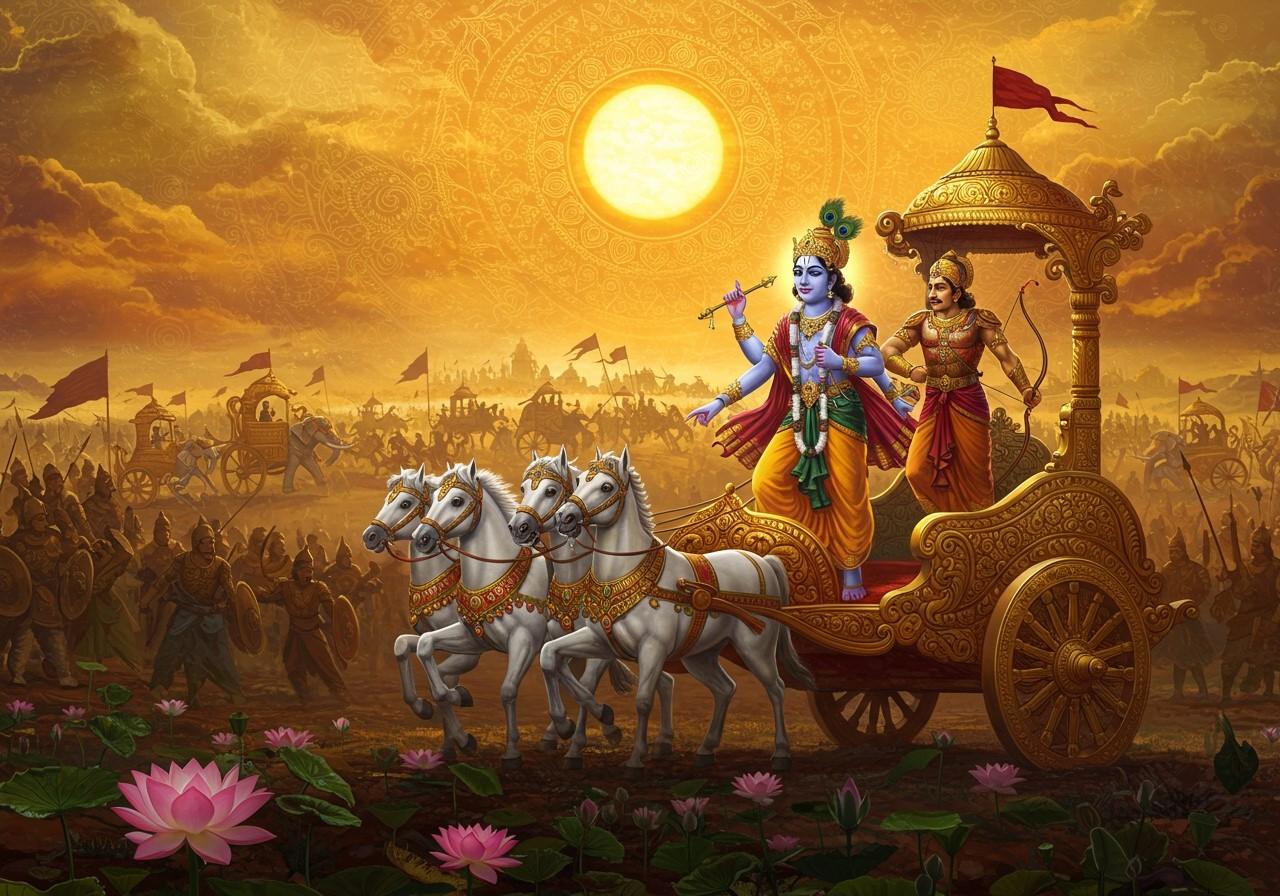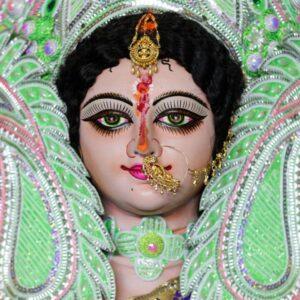
The Mahabharata, a cornerstone of Indian culture, narrates a profound tale of morality, duty, and the intricate interplay of dharma (righteousness) and adharma (unrighteousness). This exploration delves into the epic’s complex narrative, the deep-rooted causes of the Kurukshetra War, its far-reaching consequences, and its enduring relevance in contemporary society.
Unraveling the Mahabharata’s Narrative
The Mahabharata recounts the saga of two sets of cousins, the Pandavas and the Kauravas, locked in a bitter feud for the throne of Hastinapura. Compiled between 300 BC and 300 AD, this epic, attributed to Vyasa (who also features as a character), unfolds with over 100,000 two-line stanzas, making it the longest epic in world literature. Key events in this sprawling narrative include the infamous game of dice, the humiliation of Draupadi, and the timeless wisdom imparted in the Bhagavad Gita. The Kurukshetra War, a central point of the epic, underscores themes of duty, honor, and the tragic consequences of familial conflict.
Main Plot and Key Events
- Game of Dice: This pivotal event led to the Pandavas losing their kingdom and enduring years of exile, setting the stage for the escalating conflict. The game, manipulated by the cunning Shakuni, exposed the Kauravas’ treachery and the Pandavas’ vulnerability.
- Draupadi’s Humiliation: A turning point in the narrative, Draupadi’s attempted disrobing in the Kaurava court served as a powerful catalyst for the war, igniting the flames of revenge and highlighting the violation of dharma. This act of profound disrespect became a rallying cry for the Pandavas and their supporters.
- Bhagavad Gita: On the eve of battle, Krishna’s discourse to Arjuna, the Bhagavad Gita, offers profound insights into duty, righteousness, and the nature of reality. This philosophical dialogue explores the complexities of dharma and karma, providing guidance for navigating life’s moral dilemmas.
Central Characters
- Pandavas: The five Pandava brothers—Yudhishthira, Bhima, Arjuna, Nakula, and Sahadeva—represent virtues of righteousness, strength, skill, and loyalty. Their unwavering commitment to dharma forms the moral core of the story.
- Kauravas: Led by the ambitious and jealous Duryodhana, the Kauravas embody the forces of adharma. Their insatiable greed and lust for power drive the conflict and ultimately lead to their downfall.
- Krishna: As the divine charioteer and guide to Arjuna, Krishna plays a pivotal role in shaping the course of events. His wisdom and strategic counsel prove crucial to the Pandavas’ eventual victory.
- Draupadi: The wife of the Pandavas, Draupadi, emerges as a symbol of strength and resilience. Her humiliation serves as a powerful motivation for the war and underscores the importance of upholding dharma.
Seeds of Conflict: The Causes of the Mahabharata
The deep-seated rivalry between the Pandavas and Kauravas stemmed from a succession dispute, exacerbated by Duryodhana’s burning jealousy and insatiable ambition. Draupadi’s swayamvara (a ceremony where a princess chooses her husband) and the rigged game of dice orchestrated by Shakuni were significant triggers that escalated the conflict towards the inevitable war. These events, interwoven with divine interventions and the concept of cosmic justice, played crucial roles in shaping the epic’s trajectory.
Key Causes
- Succession Dispute: The battle for the Kuru throne, a symbol of power and legitimacy, became the central point of contention between the Pandavas and Kauravas. This dispute, rooted in familial ties and ambition, fueled the escalating rivalry.
- Duryodhana’s Jealousy: Duryodhana’s envy of the Pandavas’ virtues and popularity fueled his desire to eliminate them. His jealousy, coupled with his ambition, blinded him to the consequences of his actions.
- Draupadi’s Swayamvara: Arjuna’s winning of Draupadi’s hand in marriage further intensified the rivalry between the two families. This event added a personal dimension to the political conflict, deepening the animosity between the cousins.
- Game of Dice: The deceitful game of dice, orchestrated by Shakuni, served as a critical turning point. The Pandavas’ loss of their kingdom and Draupadi’s humiliation in the Kaurava court became the immediate triggers for the war.
The Philosophical Underpinnings: Why the Mahabharata Happened
Beyond the political and familial conflicts, the Mahabharata delves into profound philosophical concepts. The epic explores the intricate interplay of dharma (righteousness), karma (actions and their consequences), and the eternal struggle between virtues and vices. The Bhagavad Gita, a pivotal part of the Mahabharata, offers deep insights into duty, righteousness, and the path to self-realization.
Philosophical Themes
- Dharma and Adharma: The epic explores the complexities of dharma and adharma, highlighting the challenges of adhering to righteous conduct in a world filled with temptation and conflict. The characters’ choices and their consequences demonstrate the importance of upholding dharma.
- Karma and its Consequences: The principle of karma, where actions have consequences that shape one’s destiny, is a central theme. The Mahabharata illustrates how past actions influence present circumstances and future outcomes.
- The Bhagavad Gita’s Wisdom: Krishna’s guidance to Arjuna in the Bhagavad Gita provides a framework for understanding duty, righteousness, and the path to self-realization. The Gita’s teachings offer timeless wisdom for navigating life’s challenges.
The Aftermath: Consequences of the Kurukshetra War
The devastating Kurukshetra War left an indelible mark on the characters and the kingdom of Hastinapura. The war resulted in immense loss of life and presented complex moral dilemmas for both the victors and the vanquished. The struggle to restore dharma and rebuild a shattered kingdom became a central theme in the aftermath.
Impact and Themes
- Loss and Moral Dilemmas: The war’s devastation forced characters like Yudhishthira to grapple with the moral implications of their actions, even in victory. The heavy price of war raised questions about the true meaning of dharma and the complexities of justice.
- Redemption and Peace: In the aftermath, themes of redemption, reconciliation, and the pursuit of peace emerged. The characters’ attempts to rebuild their lives and restore order reflected the enduring human capacity for hope and renewal.
Timeless Lessons from the Mahabharata
The Mahabharata offers enduring lessons that resonate across generations. The epic emphasizes the importance of adhering to one’s duty (dharma) and the consequences of succumbing to vices like jealousy, greed, and anger. The characters’ journeys provide valuable insights into human nature and the complexities of moral decision-making.
Values and Wisdom
- Resilience and Perseverance: The Pandavas’ ability to endure hardship and remain committed to their principles highlights the power of resilience and perseverance in the face of adversity. Their unwavering spirit serves as an inspiration for overcoming challenges.
- Forgiveness and Compassion: Characters like Yudhishthira demonstrate the importance of forgiveness, even towards those who have wronged them. The epic suggests that compassion and forgiveness are essential for healing and restoring harmony.
- Justice and Righteousness: The pursuit of justice and the upholding of dharma are recurring themes throughout the narrative. The Mahabharata emphasizes that true victory lies in adhering to righteous principles, even in the face of difficult choices.
- Lord Rama: Ideal Leadership and Virtue: This blog post explores the leadership qualities and virtues of Lord Rama, providing insights into ethical leadership and dharma.
- Hindu Philosophy Explained: A Beginner’s Guide: This guide offers an introduction to Hindu philosophy, exploring key concepts relevant to the Mahabharata, such as dharma, karma, and moksha.
The Mahabharata’s Cultural Impact
The Mahabharata has profoundly influenced Indian art, literature, and performing arts for centuries. Its timeless narrative has been adapted into countless forms, including television series, films, plays, and dance performances, ensuring its continued relevance in contemporary culture.
Influence and Legacy
- Art and Literature: The epic’s complex characters, intricate plotlines, and philosophical depth have inspired countless works of art and literature across various genres. Its influence can be seen in paintings, sculptures, novels, and poems.
- Performing Arts: The Mahabharata continues to be brought to life through vibrant dance performances, theatrical productions, and musical interpretations. These performances provide a dynamic and accessible way for audiences to engage with the epic’s themes.
- Philosophy and Ethics: The Mahabharata’s philosophical teachings, particularly those found in the Bhagavad Gita, continue to shape Indian philosophical thought and ethical values. Its exploration of dharma, karma, and moksha provides a framework for moral reasoning and spiritual development.
- Hindu Symbols Explained: Their Meanings and Importance: This blog post delves into the symbolism found in Hinduism, providing context for the symbols and rituals associated with the Mahabharata.
- Ayodhya and Lanka: Ramayana Geography Explained: This post explores the geographical context of the Ramayana, another important epic in Hindu tradition, offering insights into the settings and locations of these ancient stories.
Poojn.in: Your Source for Sacred Items
Poojn.in, India’s leading online store for cultural and religious goods, offers a wide selection of items relevant to the Mahabharata and Hindu traditions. Enhance your spiritual practice with authentic products and deepen your connection to this timeless epic.
Featured Products
- Brass Laddu Gopal Murti: Beautifully crafted Laddu Gopal statues, ideal for worship and devotion. Available in various sizes and designs.
- Pure Arjun Chal (Terminalia Arjuna Bark): Known for its medicinal properties and used in traditional Ayurvedic practices.
Conclusion: The Mahabharata’s Enduring Legacy
The Mahabharata remains a timeless epic, deeply interwoven with the fabric of Indian culture and tradition. More than just a tale of a devastating war, it offers a profound exploration of human nature, the complexities of dharma and karma, and the eternal struggle between good and evil. The causes and consequences of the Kurukshetra War provide invaluable lessons about ambition, jealousy, resilience, forgiveness, and the pursuit of justice. In today’s world, the Mahabharata continues to inspire and guide us, reminding us of the importance of upholding righteous principles and striving for self-realization. Its teachings remain as relevant as ever, offering wisdom and insights for navigating the challenges of human existence.

